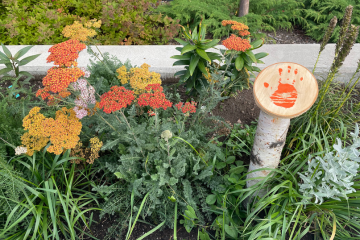News
Roots of Change: How a Volunteer's Vision Transformed Hospital Gardens
Date: 2024-05-01
Kyla Moore first began volunteering with the gardens at St. Joseph's Care Group (SJCG) after the construction of the East Wing at St. Joseph's Hospital. Noticing the new garden beds, Kyla coordinated with Building Services and Volunteer Services to fill the space with local plants. Shortly after, Volunteer Services made her title as a Garden Assistant official.
As the years went on, Kyla organized the donation of flowers and edible plants to the garden. Vegetables like tomatoes, peppers, carrots, and radishes, along with flowers such as lilies, lamb's-ear, and black-eyed Susans began to fill the gardens around the hospital site.
"I love seeing things grow," says Kyla. "Watching as plants start to poke through the ground after our long dark winters. It's hope for the future - green, lush, growing life. St. Joseph's Care Group has given me that freedom to play in the garden and get my hands dirty."
What began as an experiment - a no-plans approach to see what would take root in the soil - quickly expanded to include other local and global initiatives.
In 2022, SJCG collaborated with the Minogin Gitigaanis Society from AlterEden to create an Orange Memorial Garden outside the entrance of St. Joseph's Hospital. The garden is just one of many from the Orange Flower Memorial Project across Canada that encourages healing and recognition for the ongoing trauma of the Residential School System.
Shortly after, the gardens were also officially recognized as part of the Butterflyway Project and as a Monarch Butterfly Waystation. The Butterflyway Project, created by the David Suzuki Foundation, works to create pollinator "corridors," or ways, for butterflies in local areas. The Project is a volunteer-led movement organized by Butterflyway Rangers that aims to plant native wildflowers in public spaces to support bees and butterflies. Some of these plants, like milkweed, also support monarch butterflies, as Monarch Butterfly Waystations are places that provide the resources necessary for monarchs to continue producing new butterflies and sustain migration.
"After we planted the milkweed, I saw so many butterflies in the garden," Kyla remembers. "It made me feel really good at the end of the day - when people expressed to me how much they liked the gardens, and when they gave each other advice about growing things."
The plants that have thrived in the hospital gardens don't just support local biodiversity. but also support clients and visitors at the site. As part of their occupational therapy, clients are sometimes invited to harvest plants and enjoy the garden's bounty. Kyla hopes that with time, the garden boxes can continue to be used to support clients with their continued healing.
"Sometimes when we hear negative things in the news about the state of the planet and the future, it can be really helpful to think about how everyone can make a tiny difference. Small actions like creating a little garden or pollinator patch as a Butterflyway corridor, or growing your own veggies to eat, can have a much bigger impact. Any little thing can help combat that eco-grief we've been feeling. It gives us hope so we can make a positive impact for all the little creatures that might not have voices on this planet."
Do you have a green thumb and a passion to give back to the community? Check out exciting volunteer opportunities here.


